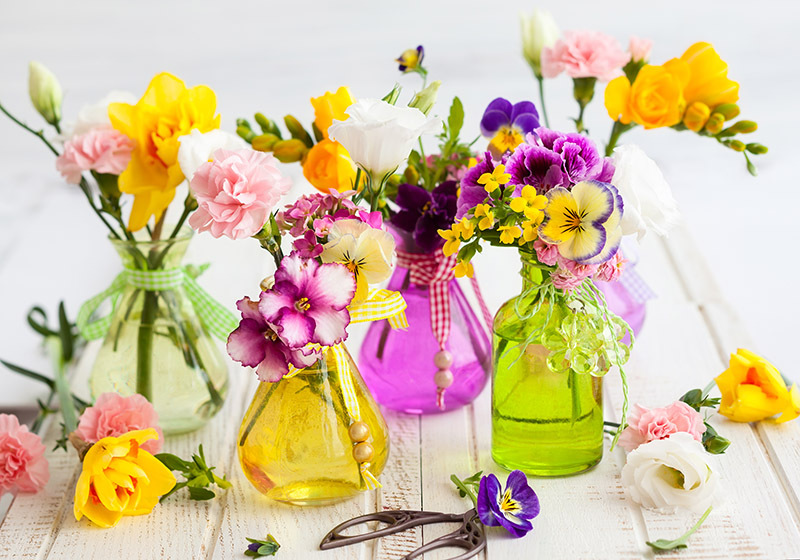Harmonize Your Orchids with Their Environment
Posted on 10/09/2025
Harmonize Your Orchids with Their Environment: The Ultimate Guide
Orchids are among the most exquisite and mysterious houseplants worldwide. Their reputation for both elegance and sensitivity makes them cherished favorites, yet they intimidate many growers. Every orchid enthusiast knows: for these beauties to thrive, harmonizing your orchids with their environment is essential. But what does this really mean? In this comprehensive guide, we'll demystify orchid care and show you easy, actionable ways to create the perfect environment for your orchids--no matter your location or growing space.
Why Does Orchid-Environment Harmony Matter?
Most orchids are native to jungle canopies, where they enjoy filtered light, high humidity, and gentle, regular airflow. To synchronize your orchids with their environment, you need to replicate these conditions at home.
Proper harmony means:
- Reducing plant stress and diseases
- Encouraging consistent growth and stunning blooms
- Increasing longevity for your orchids
- Making orchid care less challenging and more enjoyable
Understanding the natural preferences of orchids and adjusting your care routine accordingly will guarantee healthier and happier plants.

Key Factors in Harmonizing Orchids with Their Surroundings
For truly outstanding results, you need to look at several environmental variables. Each interacts with others, so balancing these elements is the secret sauce to healthy, vibrant orchids.
The Role of Light in Orchid-Environment Harmony
Orchids love light--but not just any light. Their natural habitats offer dappled sunlight that mimics the forest canopy. Too much direct sun can scorch leaves, while inadequate light leads to poor blooming.
- Bright, indirect sunlight is best for popular types like Phalaenopsis and Dendrobium.
- Cattleya and Vanda orchids can tolerate more intense light, but benefit from light-diffusing curtains or partial shade outdoors.
- Leaves should display a light, grassy green hue--dark green indicates too little light, while yellowish leaves signal too much.
When harmonizing your orchids with their environment, remember that window orientation matters:
- East or west-facing windows offer the best balance.
- South-facing windows in hot climates may require sheer curtains.
- North-facing windows might need supplemental grow lights during winter months.
Temperature: The Silent Orchid Whisperer
Orchids thrive in warm, consistent temperatures. However, different orchid species have unique tolerances. To attune your orchids to their environment, research what your particular species prefers.
- Daytime temperatures: 65-80?F (18-27?C) suit most tropical orchids.
- Nighttime temperatures: A slight drop to 55-65?F (13-18?C) mimics the natural environment and often triggers blooming.
- Never place orchids near cold drafts, heaters, or AC vents.
Tip: Many orchids need a temperature difference (drop of 10?F/5?C) between day and night to initiate flower spikes. This is key when trying to harmonize your orchids with their environment to encourage reblooming.
Humidity: Orchids Crave Moisture in the Air
Harmonizing your orchids with their environmental humidity is crucial. Most homes are drier than the tropics, especially in winter. Orchids typically prefer humidity levels between 40-70%.
- Use a humidity tray: Place a shallow tray filled with pebbles and water beneath your orchid's pot. The evaporating water raises local humidity.
- Mist your orchids lightly in the morning (never drench them, as this can promote rot).
- Group orchids together to create a humid microclimate.
- If you have many orchids, consider a small room humidifier.
Monitor carefully: Overly damp conditions can cause fungal problems. It's all about balance!
Orchid Potting Media and Root Health
An orchid's harmony with its environment extends underground. Their roots need air just as much as water. Unlike most houseplants, orchids often grow in bark, sphagnum moss, or even mounted on wood. Here's what to know:
- Choose a potting mix that matches your orchid:
- Phalaenopsis: Chunky bark or coir-based mixes
- Cymbidium: Finer bark or gravel/sand blends
- Miltonia (Pansy Orchids): Sphagnum-rich blends for moisture retention
- Repot orchids every 1-2 years: Old mix compacts over time, suffocating roots.
- Signs of root struggle: Mushy, black, or shriveled roots indicate environmental imbalance.
Water Wisely: The Art of Orchid Hydration
To harmonize your orchids with their environment, you must water in sync with both the climate and the season:
- Let the top inch of potting mix dry before watering again.
- During growth periods (spring and summer), orchids need more frequent watering.
- In winter, reduce frequency to prevent rot.
- Use room-temperature distilled or rainwater if possible; tap water often contains salts and chemicals that can harm roots.
Always water in the morning to allow excess moisture to evaporate through the day.
Microclimate Tweaks: Bring Nature Indoors
If you're serious about attuning your orchids to their surroundings, small tweaks make a big impact.
- Improving Airflow: Orchids despise stagnant air, which invites pests and fungi. Use a gentle fan nearby or crack open a window for fresh breezes.
- Green Companions: Place humidity-loving ferns or other houseplants near orchids to help regulate microenvironments.
- Location, Location, Location: Avoid placing orchids on heater vents, in bathrooms (unless bright), or where they'll get harsh afternoon sun.
- Outdoors? Many orchids can summer outdoors, as long as they avoid midday sun and are protected from wind and heavy rain.
Common Mistakes in Orchid-Environment Harmony--and How to Avoid Them
Even experienced growers slip up when conditions change. Here's how to avoid the most frequent pitfalls when harmonizing your orchids with their environment:
- Overwatering: This is the number one killer of indoor orchids. Less, not more, is usually safer.
- Improper Light: Too much or too little light leads to leaf drop, color changes, and no blooms.
- Poor Air Circulation: Trapped humidity increases disease risk. Move plants or introduce airflow as needed.
- Wrong Potting Mix: Using regular soil smothers roots--always use orchid-appropriate medium.
- Ignoring Seasonal Changes: Natural light and temperature cycles influence orchids' life phases. Monitor your home's environment as the seasons change.
Advanced Tips for Perfect Orchid-Environmental Synchrony
If you're ready to take your orchid care to the next level, try these expert tactics:
Monitor and Adjust Growing Parameters
- Use a hygrometer and thermometer: These affordable tools help you track environmental factors at a glance.
- Regularly inspect roots: Healthy roots are white or green and firm to the touch.
- Journal your results: Keeping notes on when each orchid blooms, receives new light, or is repotted helps perfect your methods.
Understand Your Orchid Species' Origins
Some orchids hail from cloud forests, deserts, or tropical lowlands. The more you know about your plant's native environment, the better you can harmonize orchids with their environmental needs. Research is key!
Experiment With Seasonal Outdoor Placement
- In temperate climates, placing orchids outdoors during the frost-free season can invigorate growth. Always shelter them from direct noonday sun and bring them in before temperatures drop.
Feed Your Orchids Properly
Orchids need food, but less is more. Use a balanced orchid fertilizer at half strength during the growing season. Over-fertilizing can damage roots and leaves, upsetting the plant's internal balance with its environment.
Troubleshooting: When Your Orchids Seem Out of Sync
If your orchids aren't harmonizing with their environment, don't panic! Common symptoms usually have clear solutions:
- Wrinkled or limp leaves: Usually from underwatering, low humidity, or root issues; check potting mix and increase humidity.
- Leaf burn: Too much direct sunlight. Move to indirect light immediately.
- Yellow leaves at the base: Often normal aging, but can signal excessive moisture or fertilizer.
- No blooms: Not enough light or not enough seasonal temperature difference.
- Black spots/fungus: Poor airflow and overwatering. Improve ventilation and reduce watering.
Remember: Orchids are resilient. With patience and the right adjustments, they will recover and reward you with spectacular blooms.
Bringing It All Together: Achieve Symbiosis for Show-Stopping Orchids
To harmonize your orchids with their environment is to craft an ongoing relationship--one of observation, adjustment, and reward. Each home and space is unique, but armed with the right knowledge, you can attune your orchids to their surroundings for abundant growth and breathtaking displays.
- Start by assessing your orchid's needs (species, light, temperature, humidity, and potting mix).
- Modify your environment (use humidity trays, adjust light, monitor temperature, and improve airflow).
- Fine-tune care seasonally, and watch for your orchids' responses.
- Be patient--harmony takes time but pays off in beauty and ease of care.

Frequently Asked Questions About Harmonizing Orchids With Their Environment
What is the best spot in my house for orchids?
The best place is a room with bright, indirect sunlight (like an east or west window), consistent temperatures, and good air circulation. Bathrooms can be ideal if they have bright light, due to naturally higher humidity.
Can I use regular potting soil for orchids?
No. Regular soil retains too much moisture and suffocates roots. Always use a special orchid mix--usually bark-based, moss-based, or a blend to suit your orchid species.
How often should I water my orchids?
This depends on potting medium, orchid type, and environment. Usually every 7-10 days for bark mixes; every 2-5 days for moss. Check moisture before watering--roots should be silver/white when dry.
Should I mist my orchid every day?
Light, morning misting can boost humidity, but do not soak leaves. Over-misting can lead to rot and fungal issues.
Why isn't my orchid blooming?
Most commonly, it's due to insufficient light or lack of a night/day temperature drop. Review your care routine and environmental harmony for best results.
Final Thoughts: Harmony Is a Journey, Not a Destination
Orchid growing is a rewarding practice when you take the time to understand and harmonize their needs with your environment. Whether you're an indoor hobbyist or a dedicated collector, creating a balanced symbiosis between your orchids and their home will ensure healthy, beautiful flowers for years to come.
Ready to harmonize your orchids with their environment? Start today--and watch your plants (and your confidence as a grower) thrive together!
Latest Posts
Peony Flowers: A Symbolic Dance of Colors and Meaning
Harmonize Your Orchids with Their Environment
The Enduring Appeal of Red Roses on Valentine's Day
Give your flowers a longer life with these easy preservation practices







